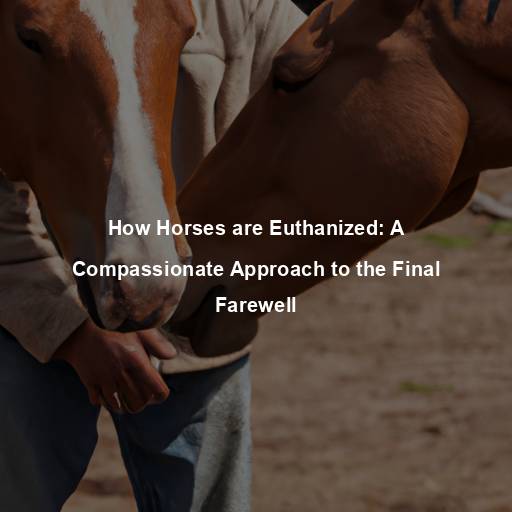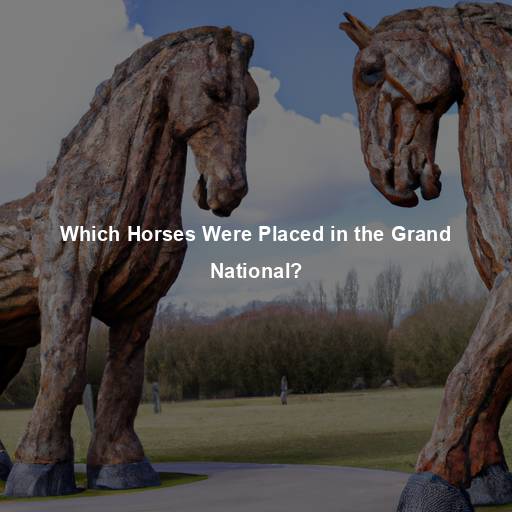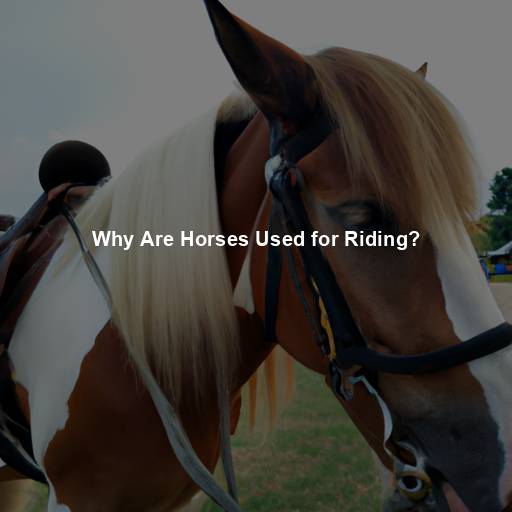How Horses are Euthanized: A Compassionate Approach to the Final Farewell
Last Updated on July 20, 2023 by Evan
Contents [hide]
- 1 Understanding Euthanasia in Horses
- 1.1 The Difficult Decision: When is Euthanasia Considered?
- 1.2 The Process of Euthanasia
- 1.3 Ethical Considerations and Welfare Standards
- 1.4 The Emotional Journey: Coping with Loss and Grief
- 1.5 Understanding the Horse’s Condition
- 1.6 Exploring Treatment Options
- 1.7 Assessing Quality of Life
- 1.8 Considering Long-Term Prognosis
- 2 Alternative Euthanasia Methods and Controversies
- 3 The Role of Equine Hospice and Palliative Care
- 4 FAQs – How Horses Are Euthanized
- 4.1 What does it mean to euthanize a horse?
- 4.2 Who is responsible for making the decision to euthanize a horse?
- 4.3 What are the methods of euthanizing a horse?
- 4.4 Is euthanasia painful for horses?
- 4.5 Where does euthanasia of horses usually occur?
- 4.6 What happens to a horse’s body after euthanasia?
- 4.7 Can I be present during the euthanasia of my horse?
- 4.8 Are there any alternatives to euthanizing a horse?
Understanding Euthanasia in Horses
The contemplation of euthanasia invariably evokes a flurry of complex emotions and an undeniable sense of melancholy. The plight of our cherished equine companions further amplifies this perplexity, as the decision to ease their suffering is fraught with emotional gravity. Painstakingly, this exposé will artfully navigate the multifaceted dimensions surrounding horse euthanasia, unravelling the intricate tapestry of its procedural intricacies, moral dilemma, and the harrowing emotional pilgrimage that horse owners and caretakers inevitably embark upon in these somber moments.
The Difficult Decision: When is Euthanasia Considered?
Making the difficult decision to euthanize a horse is never an easy task. It is a situation filled with heart-wrenching contemplation, where owners grapple with the balance between a beloved companion’s quality of life and the pain they endure. It is a journey shrouded in uncertainty, marked by conversations with experts in the field, who lend their invaluable insights in hopes of guiding the path towards the most compassionate and humane decision possible.
The Process of Euthanasia
Consultation and Consent
When it comes to the sensitive topic of euthanasia for horses, seeking guidance from a veterinarian is an imperative step. Their expertise and evaluation of the horse’s overall condition are crucial in making the right decisions. In certain situations, further tests and examinations might be required to grasp the full comprehension of the horse’s prognosis. Eventually, the owner’s consent plays a pivotal role in finalizing the decision for euthanasia.
Sedation and Anesthesia
As compassionate caretakers of our beloved equine companions, we strive to provide them with a serene and gentle transition. To alleviate any potential discomfort, a sedative is tenderly administered, allowing our magnificent horses to establish a tranquil state of mind. After this initial step, our skilled veterinarians delicately introduce an anesthetic agent intravenously, guiding our majestic friends into a profound state of unconsciousness. Through these meticulous measures, we ensure that our noble steeds are blissfully oblivious, liberated from any pain or disquietude as they embark on their final journey.
Euthanasia Solution
After the horse has been fully anesthetized, the veterinarian will administer a euthanasia solution. This solution is a carefully formulated medication, usually containing a barbiturate compound, that rapidly and painlessly stops the horse’s heart and brain activity. The euthanasia solution is typically administered through an IV injection. Once the solution is administered, the horse’s passing is swift and peaceful.
Ethical Considerations and Welfare Standards
Veterinary Expertise and Training
When it comes to euthanasia for horses, it’s vital to have a qualified veterinarian leading the way or directly overseeing the process. These professionals carry the necessary expertise, know-how, and finesse to ensure that everything is carried out humanely and with utmost professionalism. By relying on their knowledge, they can help minimize any discomfort or anguish for the horse, ensuring that their final moments are respectful and dignified. A veterinarian’s role in this procedure is truly invaluable, providing solace during such a challenging time.
Minimizing Discomfort and Stress
When it comes to euthanasia, the utmost commitment is placed on ensuring the horse’s comfort and well-being. Every possible measure is taken to diminish any unease or anxiety during the process. By utilizing sedatives and anesthetics, the horse is able to maintain a state of tranquility and serenity. Moreover, the euthanasia solution acts swiftly, leaving no room for any enduring distress.
Proper Disposal and Aftercare
After euthanasia, the horse’s body should be handled with respect and dignity. Proper disposal methods, such as burial, cremation, or rendering, should be carried out in compliance with local regulations and guidelines. Horse owners may also choose to donate the horse’s body for educational or research purposes, contributing to the advancement of veterinary knowledge.
The Emotional Journey: Coping with Loss and Grief
The loss of a horse is a profoundly emotional experience for their owners. The bond between humans and horses often runs deep, and saying goodbye to such a loyal companion can be incredibly challenging. It is essential for horse owners to acknowledge and honor their grief, seeking support from friends, family, and professionals who understand the unique nature of the human-horse relationship.
Seeking Support
During this difficult time, it is crucial for horse owners to seek support from their veterinary team, fellow horse enthusiasts, or grief counselors specializing in animal loss. Sharing their feelings and memories can provide solace and comfort, helping them navigate the grieving process.
Honoring the Horse’s Memory
For those who have had the privilege of sharing their lives with majestic equines, finding solace in preserving the memory of their beloved horses comes naturally. These devoted owners seek tangible ways to pay homage, whether through soul-stirring memorials like plaques or serene gardens that forever celebrate the unique bond they shared. Others choose to honor their horse’s legacy by immersing themselves in equine-related activities or offering their time at therapeutic centers, finding a healing connection that feels like no other. The path to navigating grief and finding solace after loss can be as enigmatic as the horse itself, but these heartfelt gestures offer a respite amidst the perplexing journey.
Understanding the Horse’s Condition
To make an informed decision about euthanasia, it is essential to have a comprehensive understanding of the horse’s condition. Veterinarians will conduct thorough examinations, review medical records, and may perform additional diagnostic tests to assess the horse’s overall health. They will assess factors such as the severity of pain or discomfort, the horse’s ability to move and eat, and the likelihood of recovery or improvement.
Exploring Treatment Options
When it comes to our beloved equine companions, veterinarians often bring forth a cornucopia of treatment possibilities, promising to alleviate their ailments and enhance their well-being. As horse owners, it becomes paramount to sift through this whirlwind of options, grappling with the bewildering dance of benefits, risks, and potential outcomes. Alongside considerations such as the horse’s age, overall health, financial constraints, and the practicality of treatment, we find ourselves immersed in a perplexing decision-making process, as we navigate the delicate balance between hope and realism.
Assessing Quality of Life
Assessing the quality of life for horses is an essential and intricate task that weighs heavily on the compassionate choice of euthanasia. Veterinarians, armed with their expertise and an arsenal of scales and scoring systems like the “Horse Grimace Scale” and the “Quality of Life Scale,” delve into multiple dimensions. They evaluate pain levels, the horse’s capacity to engage in natural behaviors, social dynamics, and the holistic state of well-being. These assessments serve as guiding lights through the labyrinthine decision-making process, ensuring the utmost care and consideration for our equine companions.
Considering Long-Term Prognosis
Another critical aspect to consider is the long-term prognosis for the horse’s condition. In cases where the horse’s condition is deemed incurable or where the chances of recovery are extremely low, euthanasia may be the most humane option. It is important to have a realistic understanding of the potential outcomes and whether the horse’s quality of life can be adequately maintained in the long run.
Alternative Euthanasia Methods and Controversies
While the intravenous injection of a euthanasia solution is the most commonly used method for horse euthanasia, there are alternative approaches that have been explored. These alternative methods aim to provide additional options or improve the process based on ethical considerations and advancements in veterinary science. However, it is important to note that these methods may have their own controversies and limitations.
Inhalant Anesthesia and Carbon Dioxide
One alternative method involves using inhalant anesthesia, such as isoflurane or sevoflurane, combined with a high concentration of carbon dioxide gas. The horse is first anesthetized with the inhalant gas, which induces unconsciousness. Subsequently, carbon dioxide is introduced to displace the oxygen, leading to respiratory arrest and ultimately causing the horse’s passing.
In recent times, there has been a growing intrigue surrounding a particular technique that boasts the promise of a gentler and less tumultuous approach. Yet, it’s essential to acknowledge that this method has not escaped the clutches of controversy entirely, as there are valid apprehensions regarding the horse’s consciousness as carbon dioxide is introduced in the initial phases.
Gunshot and Penetrating Captive Bolt
In the past, when it came to euthanizing horses, practices like gunshot euthanasia and the use of a penetrating captive bolt device took center stage. These methods relied on impactful blows to the horse’s head, with the aim of swiftly inducing unconsciousness and eventual demise. Yet, as time went on, these methods lost their luster, as doubts about accuracy and animal well-being started to cloud their reputation.
While these alternative methods may be used in specific situations, it is important to emphasize that the intravenous injection of a euthanasia solution remains the most widely accepted and practiced method due to its efficacy and controlled nature.
The Role of Equine Hospice and Palliative Care
In the realm of equine care, a fascinating and compassionate concept has emerged in recent years – the idea of equine hospice and palliative care. This alternative approach embraces the twilight moments of a horse’s life, offering solace, pain alleviation, and unwavering support for those facing the inevitable. By enveloping these majestic creatures in a realm of dignity, comfort, and utmost care, equine hospice invites us to witness the beauty and complexity of life’s final chapters.
Palliative Care Measures
Palliative care for horses often involves a combination of pain management, wound care, nutritional support, and environmental modifications to optimize the horse’s well-being. Medications, such as non-steroidal anti-inflammatory drugs (NSAIDs), opioids, or local anesthetics, may be utilized to alleviate pain and improve the horse’s comfort level. Frequent monitoring, regular veterinary visits, and adjustments to the care plan are essential components of equine hospice.
Emotional Support for Horse Owners
Equine hospice not only focuses on the well-being of the horse but also recognizes the emotional needs of the horse owners. Providing emotional support, counseling, and guidance on end-of-life decision-making can significantly alleviate the stress and anxiety that often accompany this challenging process.
Natural Passing in a Familiar Environment
When it comes to caring for horses in their twilight years, equine hospice stands out for its commitment to providing a peaceful and familiar setting for their final journey. By allowing these majestic creatures to gracefully pass away in the comfort of their own stable or pasture, their sense of security is preserved as they bid farewell to this world. Surrounded by their human caretakers and fellow equine companions, these special moments offer a profound sense of solace and connection. In the realm of equine care, embracing the principles of hospice brings forth a delicate balance of compassion and companionship during this perplexing time.
When it comes to equine hospice and palliative care, there’s no one-size-fits-all approach. Let’s get real – not every horse or every condition is a good fit. To make an informed decision, take the time to consult with a veterinarian who can assess the unique circumstances, prognosis, and available resources for the horse in question. It’s a serious matter that requires careful consideration and expert guidance.
FAQs – How Horses Are Euthanized
What does it mean to euthanize a horse?
Euthanasia refers to the deliberate and humane act of bringing a horse’s life to an end. It is performed to relieve the horse from any suffering or pain caused by disease, injury, old age, or other conditions when there is no reasonable chance of recovery or improvement in their quality of life.
Who is responsible for making the decision to euthanize a horse?
The decision to euthanize a horse is typically made by the horse’s owner in consultation with a veterinarian. The veterinarian evaluates the horse’s medical condition, assesses the prognosis, and discusses the available treatment options with the owner. Ultimately, the decision is based on what is in the best interest of the horse’s welfare.
What are the methods of euthanizing a horse?
There are commonly two main methods of euthanizing horses: injection of euthanasia solution and the use of a captive bolt gun. The injection method involves administering a lethal dose of medication, usually barbiturates, directly into the horse’s bloodstream. The captive bolt method uses a specially designed device that delivers a powerful blow to the horse’s forehead, rendering them instantly unconscious and causing brain death. Both methods are deemed humane when performed correctly by trained professionals.
Is euthanasia painful for horses?
When performed correctly by a veterinarian or a trained professional, euthanasia is believed to be painless for horses. The injection method typically induces unconsciousness within seconds, leading to a peaceful passing. The captive bolt method renders the horse instantly unconscious, ensuring they will not experience any pain or distress.
Where does euthanasia of horses usually occur?
When it comes to the delicate topic of euthanizing horses, the primary choice for the peaceful farewell takes place either in the familiar surrounds of their home stable or within the confines of a veterinary clinic. Aiming to alleviate any distress, the dedicated veterinarians endeavor to establish an atmosphere of tranquility and utmost comfort, ensuring the concerned equine is enveloped in a sense of safety and serenity throughout the entire process.
What happens to a horse’s body after euthanasia?
When it comes to the aftermath of euthanasia for horses, deciding what to do with their remains can be a perplexing undertaking, leaving owners with a range of options. The first option, burial, entails carefully laying the noble creature to rest in the earth, while strictly adhering to local regulations and protocols. As for cremation, the process involves respectfully incinerating the horse’s body, allowing owners the choice to preserve the ashes as a cherished memento. Lastly, there’s rendering, a curious path where the horse’s body embarks on a journey to a specialized facility that repurposes animal by-products into various commodities, such as pet food or even industrial materials.
Can I be present during the euthanasia of my horse?
While it ultimately depends on your preferences and the specific circumstances, many veterinarians allow owners to be present during the euthanasia process if they wish. Being present allows owners to say their final goodbyes and provide comfort to their horse during this difficult time. It is best to discuss this with the veterinarian beforehand to ensure everyone’s comfort and safety.
Are there any alternatives to euthanizing a horse?
In some situations where a horse is suffering but euthanasia is not the desired option, palliative care can be provided to manage pain and discomfort. However, it is essential to consult with a veterinarian to evaluate the horse’s condition and determine if this is a viable alternative. It is crucial to prioritize the horse’s welfare and consider euthanasia if their suffering cannot be effectively alleviated.







